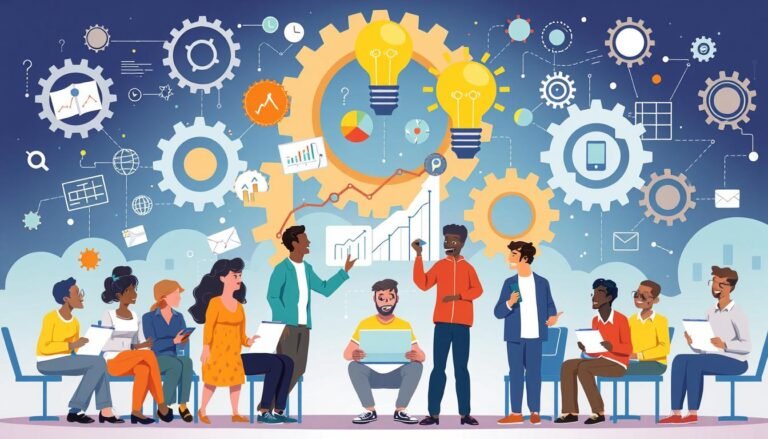Data-Driven HR Decision Making
In today’s fast-paced business world, HR Analytics is changing how companies manage their workforce. Only 41% of HR professionals use technology and data to drive business value. This shows a big chance for organizations to improve their HR strategies.
People Analytics, powered by AI and machine learning, is changing HR operations. By using these technologies, companies can make their HR strategies match their overall goals. This leads to better performance and efficiency.
Data-driven HR decision-making has many benefits. It can cut recruitment costs by up to 50%, lower attrition rates by 20%, and increase employee engagement by 15%. Learning and development programs get 25% better when made with data insights.
By using HR Analytics, organizations can make their HR function more strategic. This way, they can make decisions without bias, find trends and gaps, and build a culture based on skills. This leads to a 30% better employee satisfaction and retention.
Key Takeaways
- HR Analytics drives business value through data-driven decisions
- AI and machine learning enhance HR’s strategic role
- Data-driven HR reduces recruitment costs and attrition rates
- Analytics improve employee engagement and satisfaction
- Evidence-Based HR aligns strategies with organizational goals
- People Analytics fosters skills-based organizational culture
Introduction to Data-Driven HR
Data-driven HR is changing how companies manage their teams. It uses Workforce Analytics to make smart choices about employees. HR teams can spot trends and improve productivity and engagement with Talent Analytics.
Understanding the Concept
HR Data Science digs into metrics to understand employee behavior and trends. It helps HR teams make decisions based on facts, not just feelings. For instance, predictive analytics can predict future workforce needs accurately.
Importance of Data in HR
Data-driven HR has a big impact. Companies that use Workforce Analytics well see a 65% profit increase. This method improves many areas:
- Improving retention rates
- Enhancing talent acquisition
- Increasing workforce productivity
- Promoting diversity and inclusion
Overview of HR Analytics
HR Analytics includes tools like people analytics and predictive modeling. These tools help HR teams use data more effectively. By comparing data to industry standards, HR can understand trends better.
Data-driven HR enables organizations to optimize workforce management practices, enhancing employee engagement, and driving business performance.
Only 41% of HR professionals use data well now. But, there’s a lot of room for growth. As more companies use Talent Analytics, they’ll be ready for future challenges and innovation.
Key Benefits of Data-Driven HR Decisions
Data-Driven Talent Management changes how companies manage their workforce. It uses HR Metrics to get insights for better decisions and results.
Improved Recruitment Processes
Data-driven HR changes hiring. It uses analytics to better screen candidates, cutting bias and improving hire quality. A 10% better hire can increase team revenue by $250,000 a year.
Enhanced Employee Retention
HR Metrics help find what makes employees leave. By looking at workforce data, companies can fix issues and keep employees. This makes employees happier and saves on hiring costs.
Increased Productivity and Engagement
Insights into employee performance help managers support and reward team members. Data-driven HR leads to better training, raising productivity. Companies using advanced analytics see profits go up by 65%.
| Benefit | Impact |
|---|---|
| Quality Hire Improvement | $250,000 annual revenue increase |
| Advanced Analytics Usage | Up to 65% profit improvement |
| CEO Confidence in HR Metrics | Only 12% confident |
By using Data-Driven Talent Management, companies can tackle the biggest challenge for CEOs: Human Capital. With only 12% of CEOs trusting their HR Metrics, there’s a lot of room for growth.
Tools and Technologies for HR Analytics
HR Analytics Tools and HR Technology have changed how companies manage their teams. These tools help make decisions based on data, making HR work smoother and more efficient.
Human Resource Information Systems (HRIS)
HRIS platforms are key for managing HR data. They keep all employee info in one place, handle routine tasks, and offer insights for planning. Popular choices include Workday, BambooHR, and ADP Workforce Now.
Applicant Tracking Systems (ATS)
ATS make hiring easier by managing job ads, applications, and candidate checks. They help find the best candidates quickly. Top ATS platforms are Greenhouse, Lever, and iCIMS.
Performance Management Software
These tools help with ongoing feedback, setting goals, and reviews. They ensure everyone’s work matches the company’s goals. Examples are 15Five, Lattice, and ClearCompany.
| Tool | Key Features | Best For |
|---|---|---|
| R | Statistical analysis, Data visualization | Large datasets |
| Python | Versatile programming, Easy to learn | Data science applications |
| Excel | Intuitive interface, CSV handling | Basic HR analytics |
| Power BI | Data aggregation, Visualization | Business intelligence |
| Tableau | Advanced visualization | Data presentation |
These HR Technology solutions help companies make better choices, improve hiring, and boost employee happiness. By using these tools, HR teams can lead important projects and help the company succeed.
Data Collection Methods in HR
HR Data Collection has changed a lot. Now, companies use many tools to understand their workers better. This helps them make smart choices.
Surveys and Feedback Tools
Getting feedback from employees is key in HR today. Surveys show how workers feel, and feedback tools give quick insights. This way, HR teams can see what’s working and what’s not.
Performance Metrics
It’s important to track how well employees are doing. Key things to watch include:
- How often workers leave
- How long it takes to hire someone
- How often people are absent
- How productive they are
By looking at these numbers, HR can come up with plans to keep workers, make hiring easier, and improve overall performance.
Employee Analytics Platforms
Now, there are advanced platforms for collecting HR data. These tools bring together lots of data, giving a full picture of the workforce. They often have features like:
| Feature | Benefit |
|---|---|
| Talent Development Tracking | Find out who has the most potential |
| Skill Gap Analysis | Make training fit the needs |
| Career Path Mapping | Help employees grow |
| Engagement Monitoring | Boost happiness at work |
With these powerful tools, HR can make decisions based on facts. This leads to better strategies for managing the workforce.
Integrating Data into HR Practices
HR departments are changing. They’re moving from making decisions based on feelings to using data. This change is bringing a new era to managing talent and planning the workforce. Let’s see how Strategic HR Analytics is changing human resources.
Aligning Data with HR Strategy
HR data is more than just numbers. It’s about using insights to set company goals. By looking at employee data, HR teams can find trends and make informed decisions. This helps create strategies that really fit the workforce.
Data-Backed Talent Management
Data is making talent management better. HR can now track performance and find top performers. This helps guide training and career paths. It also helps spot future leaders early.
Predictive HR in Action
Predictive HR is a game-changer. It uses past data to predict future needs. This tool helps HR plan ahead for hiring, training, and keeping employees. By spotting issues early, companies can act before problems start.
| HR Function | Traditional Approach | Data-Driven Approach |
|---|---|---|
| Recruitment | Based on resumes and interviews | Predictive analytics for candidate success |
| Training | One-size-fits-all programs | Personalized learning paths |
| Retention | Exit interviews | Early warning systems for turnover risk |
The move to data-driven HR is not just a trend. It’s a must for companies. Those that use Strategic HR Analytics and Predictive HR get ahead. They create workplaces that are more efficient, engaged, and ready for the future.
Challenges in Data-Driven HR
Data-driven HR offers many benefits but also faces big challenges. Companies must tackle these issues to fully use HR analytics.
Data Privacy and Security Concerns
HR Data Security is a big deal in today’s world. Laws like HIPAA, CCPA, and GDPR make HR follow strict rules. Data breaches can cause identity theft and hurt trust between companies and workers.
Not following these rules can lead to big fines and harm a company’s reputation.
Managing Data Quality
Good Data Quality Management is key for AI in HR. Companies check data quality with metrics like consistency and accuracy. Bad data can lead to wrong decisions, hurting HR’s trustworthiness.
Resistance from Employees and Leaders
Starting data-driven HR can meet resistance. Many people are used to old ways and might find new data hard to understand. This can slow down using data-driven methods.
| Challenge | Impact | Solution |
|---|---|---|
| Data Privacy | Legal risks, loss of trust | Compliance with laws, robust security measures |
| Data Quality | Poor decision-making | Regular data audits, quality metrics |
| Resistance | Slow adoption of analytics | Training, communication of benefits |
To beat these challenges, a smart plan is needed. Companies should invest in protecting data, managing its quality, and teaching employees. This will help build a strong data-driven HR culture.
Case Studies of Successful Data-Driven HR
HR Analytics Case Studies show how data helps make better HR decisions. Companies in different fields have seen big improvements by using data.
Tech Companies Leading the Way
Tech leaders are using data to improve HR. For example, IBM saved $300,000,000 by cutting turnover by 25% in key roles. Nielsen also moved 40% of employees at risk to new roles, boosting their stay rate by 48%.
Industries Benefiting from Data Analytics
Data is helping many sectors. In finance, Credit Suisse saved $70,000,000 a year with predictive analytics. Best Buy saw a $100,000 boost in income per store with just a 0.1% increase in employee engagement. Experian saved $8,000,000 to $10,000,000 in 18 months by cutting attrition by 2-3%.
Lessons Learned from HR Success Stories
These stories teach us important lessons. Grupo Argos, with 13,000 employees, saw big changes in six months with a dedicated analytics team. They used data to show the impact of COVID-19, showing the need to adapt. E.ON reduced absenteeism by 11 validated hypotheses, proving data can solve HR problems.
| Company | HR Analytics Impact | Result |
|---|---|---|
| IBM | 25% decrease in turnover for critical roles | $300,000,000 saved in 4 years |
| Credit Suisse | Predictive analytics program | $70,000,000 saved annually |
| Experian | 2-3% reduction in attrition | $8,000,000 to $10,000,000 saved in 18 months |
Building a Data-Driven Culture in HR
Creating an HR Data Culture is crucial for successful Data-Driven HR Transformation. HR departments now use data from many sources. This helps them make strategic decisions and keep employees happy.
Educating HR Teams on Data Usage
To build a data-driven culture, HR teams need training. They must learn about data governance and how to organize it for insights. They also need to integrate data into the company culture. This ensures they have the best data for making decisions.
Encouraging Data-Driven Mindsets
Fostering a data-driven mindset involves identifying the right audience and understanding business issues. HR teams should pick metrics that solve key problems and track progress. By focusing on important HR issues, they can manage the company better and increase profits.
Collaborating Across Departments
Data-Driven HR Transformation needs teamwork. HR should work with other departments to manage employee data. They should use HR platforms or data warehouses and share insights. This teamwork improves workforce planning, payroll, and training.
| Data-Driven HR Benefits | Implementation Steps |
|---|---|
| Enhanced employee retention | Centralize employee data |
| Improved strategic management | Select relevant metrics |
| Streamlined HR processes | Collaborate with other departments |
| Better decision-making | Implement HR analytics software |
By following these steps, HR can build a strong data culture. This culture supports business goals and helps the organization grow.
Future Trends in Data-Driven HR
The HR world is changing fast, thanks to data-driven methods. New trends are set to change how HR uses analytics and makes decisions.
The Rise of Artificial Intelligence
AI is making a big impact in HR, changing how companies manage their teams. AI can look at lots of employee data, giving insights that were hard to get before. This helps HR make better choices about hiring, keeping, and growing talent.
Gamification in HR Analytics
Gamification is becoming a big deal in HR analytics. It uses game elements to make data collection fun and engaging. This way, companies get better data and employees have more fun.
Real-Time Data Processing
The future of HR analytics is all about processing data in real-time. Thanks to new tech, HR can now analyze data as it happens. This means they can make fast decisions and keep up with changing trends.
These trends will shape the future of HR analytics. Companies that use AI, gamification, and real-time data will attract and keep the best talent. These new methods make HR more effective, efficient, and focused on employees.
Best Practices for HR Data Analysis
HR data analysis is key for companies to use their workforce data well. By using these strategies, businesses can find valuable insights. This helps change HR processes for the better.
Setting Clear Objectives
The first step is to set clear goals. For example, a company might want to cut employee turnover by 20% in a year. Having clear goals helps focus on what matters most.
Regularly Reviewing Data Metrics
It’s important to regularly check HR metrics. This keeps data accurate and finds trends. Companies should watch KPIs like employee engagement, retention rates, and how fast they hire.
| Metric | Frequency | Impact |
|---|---|---|
| Employee Engagement | Quarterly | Improved productivity |
| Turnover Rate | Monthly | Reduced hiring costs |
| Time-to-Hire | Per recruitment cycle | Faster talent acquisition |
Creating Actionable Insights
Turning data into useful HR insights is key. For example, if data shows mentorship programs cut turnover by 30%, HR can grow these programs. This boosts retention.
By following these best practices, companies can make better decisions. They can improve employee experiences and succeed through data-driven HR strategies.
Conclusion: Embracing Data-Driven Decision Making in HR
The future of HR is all about using data. By 2025, CHROs will focus on important metrics. These include employee engagement, retention rates, and performance analytics.
Data-driven HR brings big benefits. It helps reduce bias in hiring, boosts diversity, and makes teams more flexible. Companies like Lenskart have seen great results by using AI for hiring.
But, there are challenges like data silos and privacy issues. Yet, the benefits are huge. Honda’s use of data for hiring and keeping employees shows the power of this approach. As HR changes, using data will be crucial for success.
Source Links
- What is data-driven decision-making in HR, and how is AI leveraging it? | 365Talents
- What is Data-Driven HR and How it Can Help You Make Better People Decisions
- Data-Driven HR: Definition and Process (2024) | Visier
- Data-Driven HR: Leveraging Analytics for Decision-Making
- 11 Benefits of HR Data Driven Decision Making – OrgMapper
- Making Informed Decisions: The Importance of Data-Driven HR
- 10 Reasons to Shift to a Data-Driven HR Model | Visier
- Top 9 HR Analytics Tools
- HR Analytics: How to Enhance Decision-Making with Data-Driven Insights | Human Resources
- What Is HR Analytics and How Can Data Improve Decision-Making?
- HR metrics and analytics for data-driven decisions | Blog | PurelyHR
- Best Ways to Build an HR Data-driven Culture
- The Rise of Data-driven Decision-making in Human Resources Management • Government Events
- HR Data Integration: How To Streamline Your Data
- Data-Driven Decision Making in HR | How AI is Transforming?
- The Biggest Challenges And Pitfalls Of Data-Driven, AI-Enabled HR
- The Power and Pitfalls of Data-Driven Decision Making in HR
- Case Study: Creating a Data-Driven HR Organization at Grupo Argos
- 15 HR Analytics Case Studies with Business Impact
- Top 10 HR Analytics Case Studies
- 4 Methods to Achieve Data-Driven HR in your Organization –
- How To Build A Data Driven Culture In HR
- The Evolution Of Data-Driven And AI-Enabled HR
- THE FUTURE IS DATA-DRIVEN HR DECISION MAKING AND PEOPLE ANALYTICS
- Unlocking HR Potential with Data Analytics | Best Practices
- Unlock the Power of HR Analytics: Your Guide to Data-Driven Decision Making in Human Resources
- HR Analytics and Data-Driven Decision Making: The Future of HR
- The Power of Data-Driven Decision Making in HR: Preparing for 2025
- Embracing Data-Driven HR: The Importance of HR Analytics








